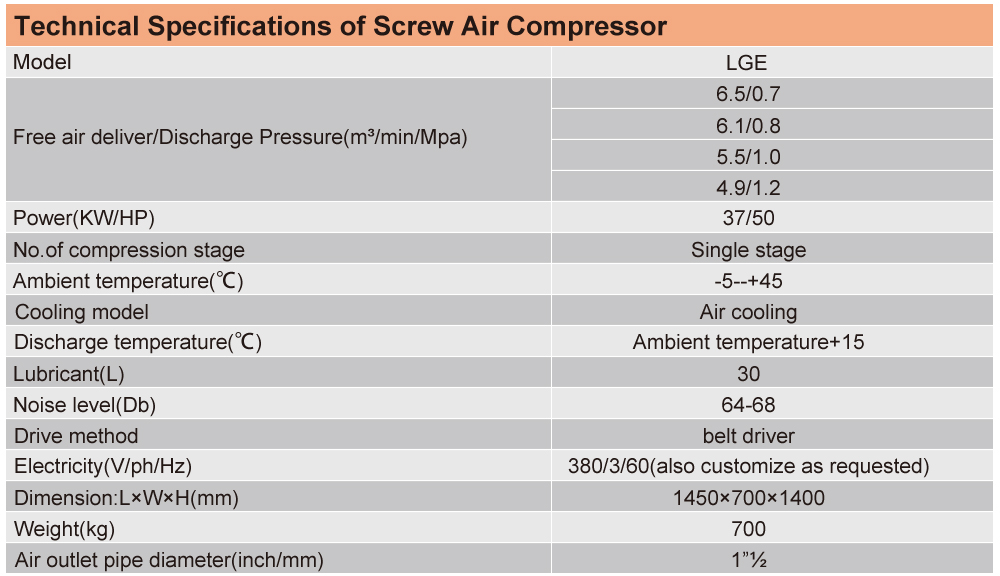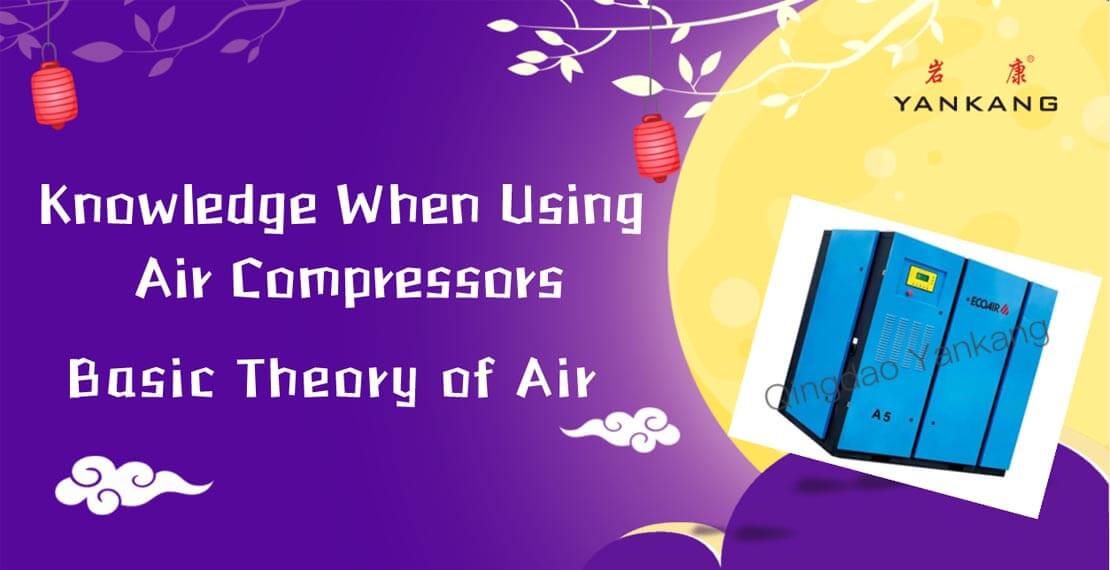Air compressors are an important part of blow molding machines. To use the air compressor correctly, you need to understand the basic theory of air.
Next, Yankang will introduce the basic principles of air in detail from 14 aspects.
let’s start.
1. What is air? What is normal air?
Answer: The atmosphere around the earth, we used to call it air. The air in a state where the predetermined pressure is 0.1 MPa, the temperature is 20°C, and the relative humidity is 36% is normal air. Normal air differs from standard air in temperature and contains moisture. When there is moisture in the air, once the water is separated, the amount of gas will be reduced.
2. What is the definition of the standard state of air?
Answer: The standard state is defined as the air state when the air suction pressure is 0.1 MPa and the temperature is 15.6 °C (the domestic industry definition is 0 °C). In the standard state, the air density is 1.185kg/m3 (the air compressor discharge capacity, dryer, filter, and other post-processing equipment processing capacity are marked with the flow rate under the air standard state, the unit is written Nm3/min ).
3. What is saturated air and unsaturated air?
Answer: Under certain temperature and pressure, the content of water vapor in wet air (ie water vapor density) is limited; when the amount of water vapor at a certain temperature reaches the maximum possible content, then the wet air is called saturated air.
The wet air when the water vapor does not reach the maximum possible content is called unsaturated air.
4. Under what conditions does unsaturated air become saturated air? What is “condensation”?
Answer: Unsaturated air is a moment of saturated air. Liquid water will condense in the humid air. This phenomenon is called “condensation”. Condensation is common.
For example, the humidity of the air in summer is very high, and it is easy to form water droplets on the surface of the water pipe. In the morning of winter, water droplets will appear on the glass windows of the residents. These are the humid air-cooled to a dew point under constant pressure. Temperature and condensation results.

5. What is the partial pressure of water vapor in wet air?
Answer: Wet air is a mixture of water vapor and dry air. In a certain volume of humid air, the amount of water vapor (by mass) is usually much less than that of dry air, but it occupies the same volume as dry air. , also have the same temperature. The pressure of the humid air is the sum of the partial pressures of the constituent gases (i.e., dry air and water vapor). The pressure of water vapor in wet air, called the partial pressure of water vapor, is referred to as Ρso. The value reflects the amount of water vapor in the humid air. The higher the water vapor content, the higher the partial pressure of water vapor. The partial pressure of water vapor in saturated air is called water vapor saturation partial pressure and is recorded as Ρab.
6. What is the humidity of the air? How many kinds of humidity?
Answer: The physical quantity indicating the degree of dryness and humidity of the air is called humidity. Commonly used humidity means absolute humidity, relative humidity. In the standard state, the mass of wet air containing water vapor in a volume of 1 m3 is called the “absolute humidity” of the humid air, and the unit is g/m3. Absolute humidity only indicates how much water vapor is contained in a unit volume of moist air, and does not indicate the ability of the humid air to absorb water vapor, that is, it does not indicate the degree of humidity of the moist air. Absolute humidity is also the density of water vapor in wet air.
The ratio of the amount of water vapor actually contained in the humid air to the maximum possible amount of water vapor at the same temperature is called “relative humidity” and is usually expressed by φ. The relative humidity φ is between 0 and 100%. The smaller the value of φ, the drier the air is, the stronger the water absorption capacity is; the larger the value of φ, the more humid the air and the weaker the water absorption capacity. The moisture absorption capacity of wet air is also related to its temperature. The temperature of the humid air rises and the saturation pressure increases accordingly. When the content of water vapor does not change, the relative humidity φ of the wet air will decrease, that is, the moisture absorption capacity of the wet air. increase. Therefore, the air compressor room should be installed to keep ventilation, reduce temperature, no drainage in the room, and accumulate water to reduce the moisture in the air.
7. What is wet air?
Answer: The air containing a certain amount of water vapor is called wet air, and the air without water vapor is called dry air. The air around us is all wet air. At a certain altitude, the composition and proportion of dry air are basically stable, and it has no special significance for the thermal performance of the entire wet air. Although the water vapor content in the humid air is not large, the change in the content has a great influence on the physical properties of the wet air. The amount of water vapor determines the degree of dryness and humidity of the air. The working object of the air compressor is wet air.
8. What are the compressed air drying methods?
Answer: Compressed air can remove water vapor by means of pressure, temperature drop, adsorption, etc., and liquid water can be removed by heating, filtration, mechanical separation, and the like. A refrigerated dryer is a device that cools compressed air to remove water vapor contained therein and obtain relatively dry compressed air. The rear cooler of the air compressor also uses cooling to remove the water vapor contained therein. The adsorption dryer uses the adsorption principle to remove the vapor contained in the compressed air.

9. What is the compressed air? What are their characteristics?
Answer: The air is compressible. The air is compressed by the air compressor to reduce the volume of the air. The air after the pressure is increased is called compressed air.
Compressed air is an important power source. Compared with other energy sources, it has the following obvious characteristics: clear and transparent, convenient to transport, no special harmful performance, no pollution or low pollution, low temperature, no fire hazard, not afraid Overloaded, can work in many adverse environments, easy to access, inexhaustible.
10. What impurities are contained in the compressed air?
Answer: The compressed air discharged from the air compressor contains a lot of impurities:
① water, including water mist, water vapor, condensed water;
② oil, including oil and oil vapor;
③various solid substances, such as rust mud, metal powder, rubber fines, tar particles, and filter materials, fine materials of sealing materials, etc., in addition to a variety of harmful chemical odor substances.
11. What is a gas source system and what is it?
Answer: The system consisting of equipment that produces, processes, and stores compressed air is called a gas source system.
A typical air supply system usually consists of the following components: air compressor, rear cooler, filter (including pre-filter, oil-water separator, pipeline filter, degreasing filter, deodorizing filter, sterilization filter), etc.), regulated gas storage tanks, dryers (freezer or adsorption), automatic drains, gas pipelines, pipeline valves, meters, etc. The above devices are combined into a complete gas source system according to the different needs of the process flow.
12. What are the hazards of impurities in compressed air?
Answer: The compressed air output from the air compressor contains a lot of harmful impurities. The main impurities are solid particles, moisture, and oil in the air.
The vaporized lubricating oil will form an organic acid corrosion equipment, which will deteriorate the rubber, plastic, and sealing materials, block the small holes, cause valve malfunction, and pollute the product. The saturated water in the compressed air will condense into water under certain conditions and accumulate in some parts of the system. These moistures rust the components and pipes, causing the moving parts to become stuck or worn, causing the pneumatic components to malfunction and leak; in cold regions, moisture freezing can cause the pipes to freeze or freeze. Impurities such as dust in the compressed air can wear the relative moving surfaces in cylinders, pneumatic motors, and pneumatic reversing valves, reducing the life of the system.

13. Why should the compressed air be purified?
Answer: Like the hydraulic system, which has higher requirements for the cleanliness of hydraulic oil, the pneumatic system also has higher quality requirements for compressed air. The air discharged by the air compressor cannot be directly used by pneumatic devices. The air compressor draws air containing moisture and dust from the atmosphere, and the temperature of the air after being compressed is increased to 100°C or more, and the lubricating oil in the air compressor is partially turned into a gaseous state. Thus, the compressed air discharged from the air compressor is a high-temperature gas containing oil, moisture, and dust. If this compressed air is directly sent to the pneumatic system, the reliability and service life of the pneumatic system are greatly reduced due to poor air quality, and the losses caused by the air source treatment device often exceed the cost and maintenance cost of the gas source treatment device. A gas source treatment system is absolutely necessary.
14. What is the reason why compressed air is widely used in the industry?
(1) Storage. It is easy to store large volumes of compressed air as needed.
(2) Simple design and control. The pneumatic components are simple in design and are therefore suitable for automated systems with simpler control.
(3) Choice of exercise. Pneumatic components are easy to achieve linear and rotary motion with step-less speed regulation.
(4) Compressed air production system, due to the appropriate price of pneumatic components, the cost of the whole set of equipment is low, and the long life of pneumatic components and low maintenance costs.
(5) Reliability. Pneumatic components have a long working life, so the system has high reliability.
(6) Harsh environment adaptability. Compressed air is largely unaffected by high temperatures, dust, and corrosion, which is beyond the reach of other systems.
(7) The environment is clean. Pneumatic components are clean and have special exhaust air treatment methods that are less polluting to the environment.
It will not cause a fire in a dangerous place. If the system is overloaded, the actuator will only stop or slip.
The above is what Yankang shared with you about the basic theory of air in air compressors.
To learn more about blow molding machines, please visit Yankang Plastic Machinery.

